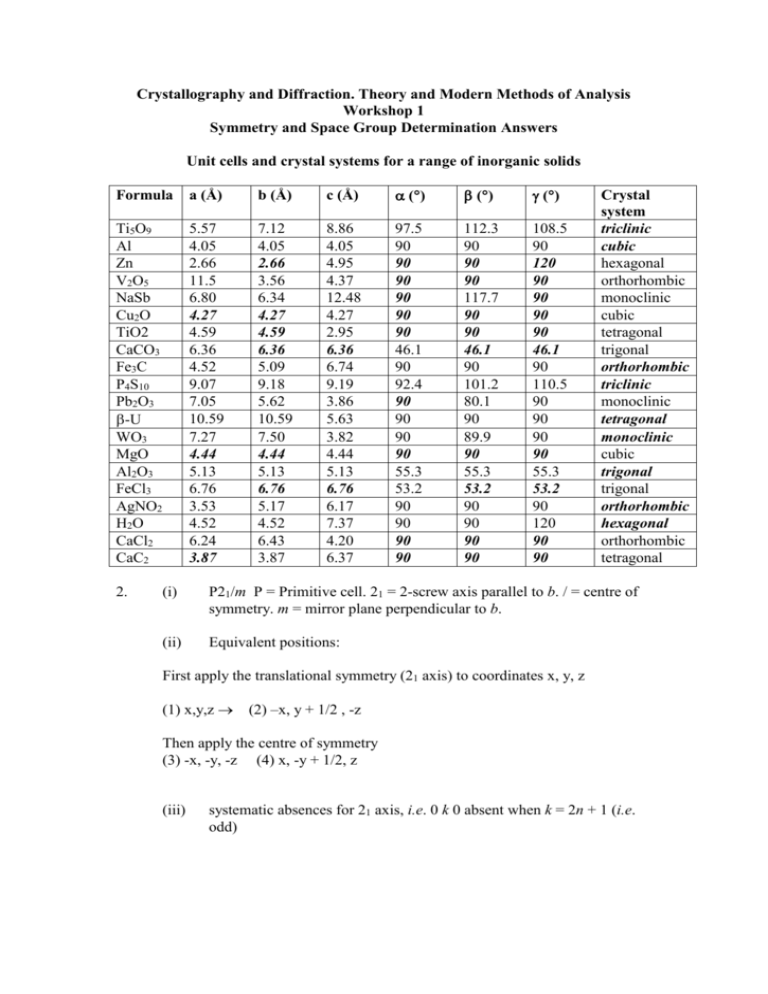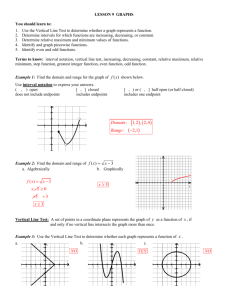Principles of Inorganic Chemistry
advertisement

Crystallography and Diffraction. Theory and Modern Methods of Analysis Workshop 1 Symmetry and Space Group Determination Answers Unit cells and crystal systems for a range of inorganic solids Formula a (Å) b (Å) c (Å) () () () Ti5O9 Al Zn V2O5 NaSb Cu2O TiO2 CaCO3 Fe3C P4S10 Pb2O3 -U WO3 MgO Al2O3 FeCl3 AgNO2 H2O CaCl2 CaC2 5.57 4.05 2.66 11.5 6.80 4.27 4.59 6.36 4.52 9.07 7.05 10.59 7.27 4.44 5.13 6.76 3.53 4.52 6.24 3.87 7.12 4.05 2.66 3.56 6.34 4.27 4.59 6.36 5.09 9.18 5.62 10.59 7.50 4.44 5.13 6.76 5.17 4.52 6.43 3.87 8.86 4.05 4.95 4.37 12.48 4.27 2.95 6.36 6.74 9.19 3.86 5.63 3.82 4.44 5.13 6.76 6.17 7.37 4.20 6.37 97.5 90 90 90 90 90 90 46.1 90 92.4 90 90 90 90 55.3 53.2 90 90 90 90 112.3 90 90 90 117.7 90 90 46.1 90 101.2 80.1 90 89.9 90 55.3 53.2 90 90 90 90 108.5 90 120 90 90 90 90 46.1 90 110.5 90 90 90 90 55.3 53.2 90 120 90 90 2. Crystal system triclinic cubic hexagonal orthorhombic monoclinic cubic tetragonal trigonal orthorhombic triclinic monoclinic tetragonal monoclinic cubic trigonal trigonal orthorhombic hexagonal orthorhombic tetragonal (i) P21/m P = Primitive cell. 21 = 2-screw axis parallel to b. / = centre of symmetry. m = mirror plane perpendicular to b. (ii) Equivalent positions: First apply the translational symmetry (21 axis) to coordinates x, y, z (1) x,y,z (2) –x, y + 1/2 , -z Then apply the centre of symmetry (3) -x, -y, -z (4) x, -y + 1/2, z (iii) systematic absences for 21 axis, i.e. 0 k 0 absent when k = 2n + 1 (i.e. odd) 3. WO2Cl2 (i) (ii) Space group C2/c Systematic absences: C c hkl absent when h + k odd h0l absent when l odd Equivalent positions First apply the translational symmetry (c-glide) (1) x, y, z (2) x, -y, z + ½ Then apply the centre of symmetry to these (3) -x, -y, -z (4) –x, y, -z + ½ Finally we need to generate the positions associated with the extra point of origin at ½ , ½ , 0 (1) x, y, z (2) x, -y, z + ½ (3) -x, -y, -z (4) –x, y, -z + ½ (5) x + ½ , y + ½ , z (6) x + ½ , -y + ½ , z + ½ (7) -x + ½ , -y + ½ , -z (8) –x + ½ , y + ½ , -z + ½ (4) Braggs law n = 2dsin Use Bragg's law to calculate d-spacings in Å. h k 1 1 2 0 2 2 3 1 2 2 l 1 0 0 1 2 2() 36.91 42.88 62.27 74.61 78.61 d(Å) 2.435 2.109 1.491 1.272 1.217 a-axis from 2 0 0 reflection d200 = a/2, therefore a = 2.109 x 2 = 4.218 Å get b axis from 2 2 0 reflection using the equation 1 h2 k 2 l 2 d 2 a 2 b2 c2 Therefore: 1 22 22 0 (1491 . ) 2 (4.218) 2 b 2 solving for b b = 4.216Å Similarly use 1 1 1 reflection to get c-axis. 1 h2 k 2 l 2 d 2 a 2 b2 c2 Therefore: 1 1 1 1 2 2 2 2 (2.435) (4.218) (4.216) c solving for c c = 4.218Å i.e cubic within the probable error. 5. (i) YBa2CuO5 orthorhombic First look for general absences (affecting all hkl) None so must be primitive P Then look for translation symmetry on each axis a axis h00 absent when h odd => 21 parallel to a 0kl absent when k odd b glide perpendicular to a b axis 0k0 absent when k odd => 21 parallel to b h0l absent when h + l odd => n glide perpendicular to b c axis 00l absent when l odd => 21 parallel to c hk0 no absences Possible space groups P21/b, 21/n, 21 or P21/b, 21/n, 21/m i.e. in short form Pbn21 or Pbnm (actually Pbnm) (ii) BICOVOX tetragonal Use determinative tables here General absences hkl absent when h+k+l odd i.e. I centred h00, 0k0 and 00l, absent when h, k, l odd (implicit from I condition) hhl absent when l odd (implicit from I condition) Possible space groups I4, I-4, I4/m, I422, I4mm, I-42m, I4/mmm (actually I4/mmm) (iii) ZnO hexagonal Use determinative tables here Look for reflections of the type hkil where (i = h+k) h-h0l absent completely hh-2hl absent when l odd 000l absent when l odd Possible space groups P63mc, P-62c, P63/mmc (actually P63/mmc) (iv) Al2O3 Trigonal Use determinative tables Note i = -(h + k) hkil condition –h+k+l = 3n 000l condition l = 6n R3c or R-3c (actually R3c)







